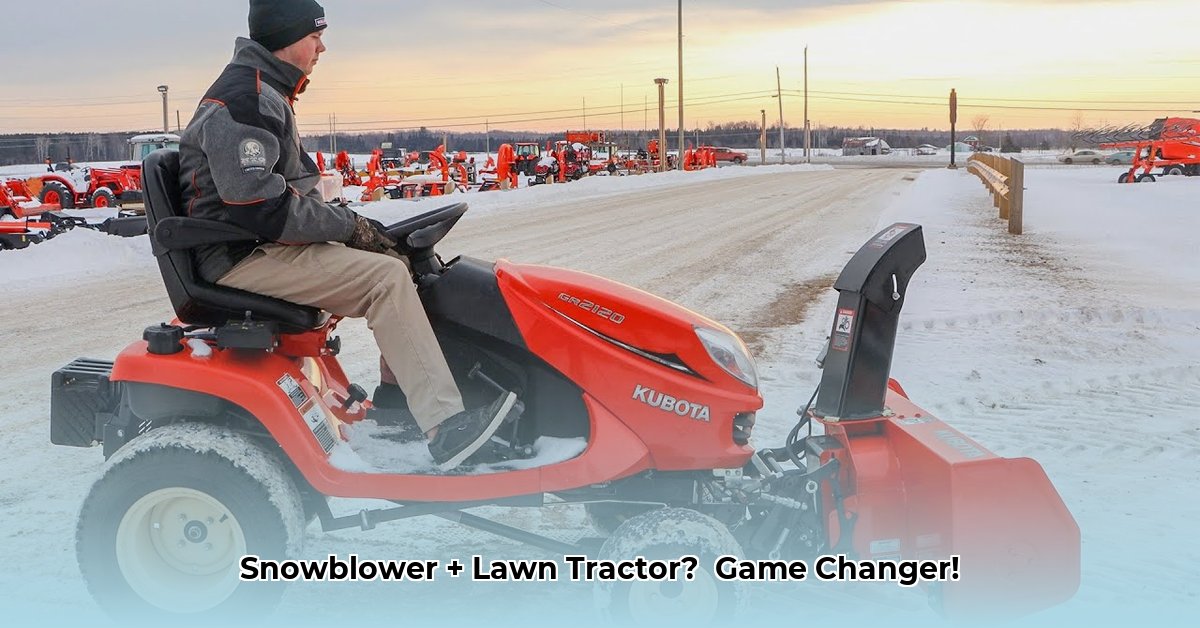
Winter's arrived, and with it, the inevitable snow. But wrestling with a shovel is so last century. This comprehensive guide helps you select, install, and safely operate the perfect snowblower attachment for your lawn tractor, transforming snow removal from a chore into a breeze. We'll compare top models, offering a data-driven approach to help you make the best decision for your needs and budget. For even more information on lawn tractors with snow blowers, check out this helpful resource: Lawn Tractor Snow Blowers.
Choosing the Right Snowblower Attachment
Selecting the ideal snowblower attachment hinges on several key factors:
Tractor Compatibility: A Critical First Step
Before anything else, verify compatibility with your lawn tractor's make, model, and horsepower rating (HP). Consult both your tractor's owner's manual and the snowblower's specifications. Manufacturers often provide compatibility charts; these are invaluable resources. Using an incompatible attachment risks damaging both the tractor and the blower itself. Is your tractor powerful enough?
Clearing Width: Optimizing Efficiency
Clearing width dictates how much area you cover with each pass. Larger widths (e.g., 72 inches) are faster for large areas but demand more powerful tractors. Smaller widths (42-50 inches) suffice for smaller areas and less powerful tractors. Consider the size of your driveway and walkways to determine the optimal width for your needs. What size is right for your space?
Power Source: PTO vs. Pulley Systems
PTO (Power Take-Off) powered snowblowers generally offer smoother operation and simpler installation. Pulley systems can be more mechanically complex. Evaluate your mechanical aptitude and choose the system you are most comfortable with. Which power source best suits your skills?
Features: Balancing Convenience and Cost
Electric chute rotation and lift assist offer convenience, but increase cost. Manual adjustments are cheaper but demand more physical effort. Consider your budget and whether you prioritize ease of use over cost savings. How much are you willing to spend for added convenience?
Comparing Top Snowblower Models (2025)
The following table compares key features and specifications of popular snowblower attachments. Remember that pricing can vary, depending on retailer and sales. Consider your needs carefully before purchasing.
| Model | Clearing Width | Throw Distance | Power Source | Chute Adjustment | Approximate Price Range | Pros | Cons |
|---|---|---|---|---|---|---|---|
| Ariens Deluxe | 48 inches | 30 feet | PTO | Electric | $$$ | Easy to use; efficient snow clearing | Requires more powerful tractors for heavier snow |
| Toro Power Max | 50 inches | 25 feet | PTO | Electric | $$$$ | Wide clearing path; reliable performance | Pricey; may be overkill for smaller driveways |
| Simplicity 60" | 60 inches | 40 feet | PTO | Manual | $$$$$ | Exceptional clearing power for heavy snow | Requires powerful tractor; heavy snow only |
| Husqvarna 50" | 50 inches | 25 feet | PTO | Electric | $$$$ | Easy to use, electric controls | Higher initial investment |
| Husqvarna 42" | 42 inches | 20 feet | PTO | Manual | $$$ | Lower cost, reliable performance | Manual adjustments can be more tiring in heavy snow |
| NorTrac 72" | 72 inches | 40 feet | PTO | Manual | $$$$$ | Wide clearing path, fewer passes | Requires a more powerful tractor, manual controls |
| NorTrac 54" | 54 inches | 30 feet | PTO | Manual | $$$$ | Good balance of width and power | Manual adjustments, may struggle in very heavy snow |
Step-by-Step Installation Guide
Installing your snowblower attachment is straightforward but requires careful attention:
Read the Manual: Familiarize yourself with your specific model's instructions. This is crucial for a successful installation.
Gather Tools: Assemble the necessary tools (wrenches, sockets, screwdrivers) before you begin.
Attach Mounting Brackets: Securely attach the snowblower's mounting brackets to your lawn tractor, ensuring proper alignment.
Connect the Snowblower: Attach the snowblower to the brackets, ensuring all connections are tight and secure.
Connect the Power Source: Engage the PTO shaft or pulley system, following the manufacturer's instructions.
Test Run: Before tackling your driveway, perform a test run in a safe, open area to verify proper function and identify any issues.
Safe Snowblower Operation: Prioritizing Safety
Safe operation is paramount:
Clear the Area: Remove any obstacles from the snowblower's path before starting.
Wear Protective Gear: Use gloves, eye protection, and a warm hat.
Maintain Safe Distance: Keep a safe distance from the spinning chute to avoid injury.
Handle Clogs Safely: Turn off the snowblower before clearing blockages. Never reach into moving parts.
Regular Maintenance: Regular maintenance extends your snowblower's lifespan and ensures optimal performance. Consult your owner’s manual for recommended maintenance schedules.
Conclusion: Making the Right Choice
The best snowblower for you depends on your individual needs and budget. Consider the size of your driveway, the amount of snowfall you typically experience, and your budget. Prioritize safety throughout the selection, installation, and operation processes. With careful planning, you'll conquer winter's snowfall with ease and efficiency.